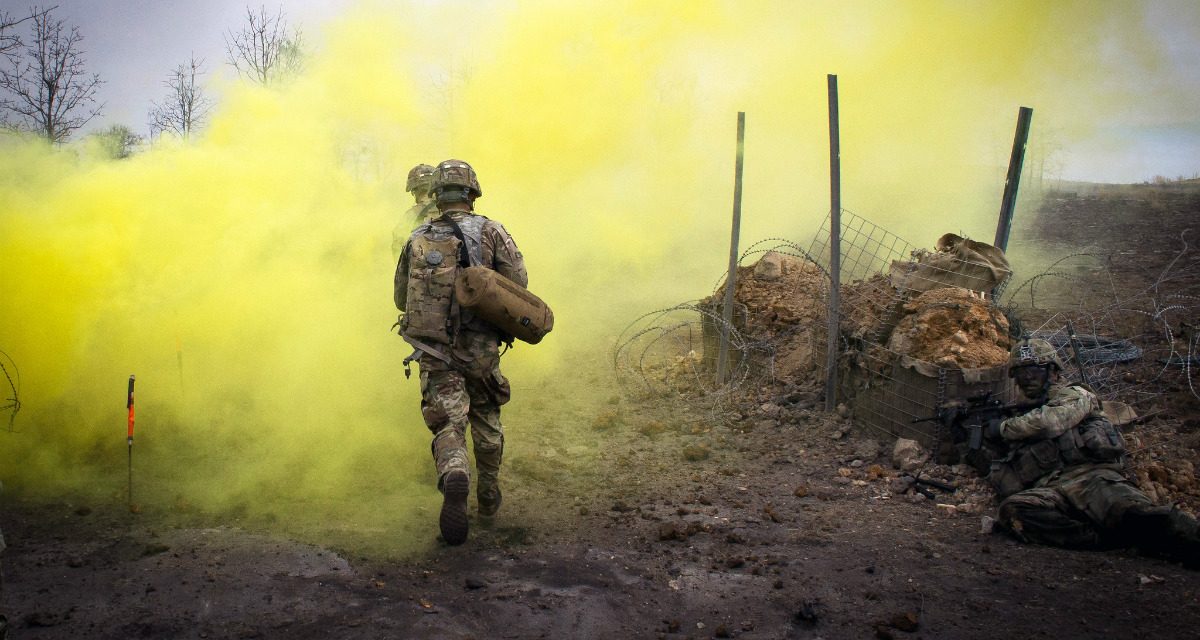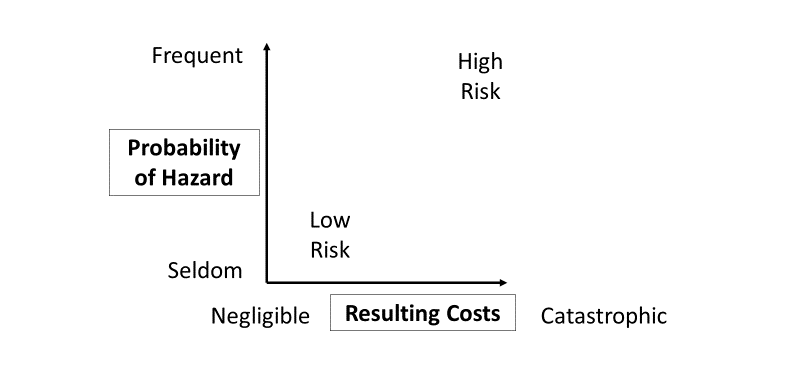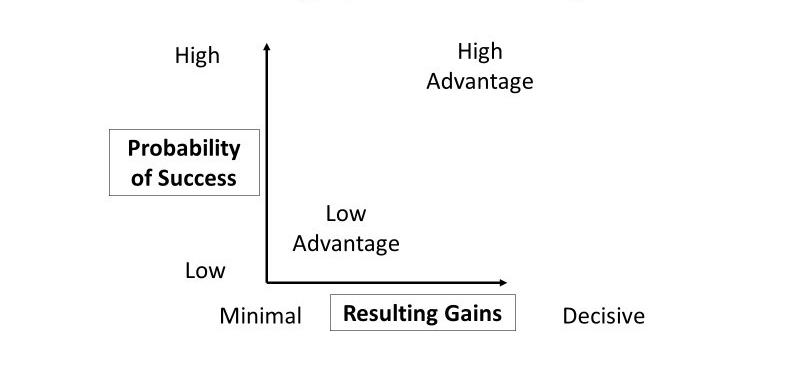I think we’re overly centralized, overly bureaucratic, and overly risk averse, which is the opposite of what we’re going to need in any type of warfare, but in particular the warfare that I envision.
—Gen. Mark Milley, US Army chief of staff
In a recent essay, retired Col. Kevin Benson calls on the Army to evolve its collective thinking on tactical risk assessment. As he points out, commanders must not be content to avoid risk. Instead, they must deliberately accept tactical risk to create and exploit relative advantages over the enemy. Col. Benson is correct that the Army must revisit how it doctrinally defines tactical risk. However, the chief obstacle to tactical risk taking is not doctrine; it is risk aversion.
From a military perspective, this propensity to avoid risk is most problematic in situations where taking risk is advantageous. There are three main reasons Army commanders tend avoid risk: loss aversion, institutional risk norms, and senior leaders’ lack of comfort with risk.
To overcome risk aversion, the Army should strive to deliberately train commanders as risk adapters. Risk adapters do not avoid risk like most people, nor do they seek it out like gamblers or adrenaline junkies. Instead, they weaponize it. Risk adapters use risk deliberately and precisely to create relative advantages in particular domains. Risk research has found three strategies that Army commanders can use to become risk adapters: perspective taking, risk norming, and decision framing.
Why Army Commanders Avoid Risk
The first reason Army commanders avoid risk is loss aversion. In the Twitter exchange that Col. Benson says prompted his article, Brig. Gen. Patrick Donahoe argues, “With great risk should come great reward. If the risk-benefit analysis is skewed to the risk outweighing the benefit the COA is not acceptable.” While this is true, it assumes a commander will accept the risk if the reward is greater. According to behavioral economists, this is rarely the case because of loss aversion—the tendency for people to fear losses more than they desire equivalent gains.
The following experiment demonstrates this idea: I flip a coin. If it lands on tails, you lose $100. How much would you have to gain to make this gamble acceptable? The average person will ask for $200, or two times the potential loss. Daniel Kahneman calls this the loss aversion ratio, and for most people it is between 1.5 and 2.5. The negative emotions associated with potentially losing $100 drives people to demand a much higher upside before accepting risk. In doing so, however, they pass up opportunities that are below their loss aversion ratio but where the rewards nevertheless outweigh the risks.
Uncertainty compounds the effects of loss aversion because people tend to overestimate risk when they are uncertain. Economist Peter Bernstein describes an experiment in which 120 students were asked to estimate the probability of dying from unnatural causes. Students estimated the percentage of deaths caused by an accident at 32 percent, murder at 10 percent, and other unnatural causes at 11 percent. The actual figures are 5 percent, 1 percent, and 2 percent, respectively.
None of this bodes well for tactical risk calculation. The uncertain nature of combat combined with a natural inclination toward loss aversion means Army leaders will struggle to correctly weigh potential gains against potential costs as Brig. Gen. Donahoe suggests. Army commanders are more likely to overestimate tactical risk, try to avoid potential losses, and pass up good tactical opportunities as a result.
The second reason Army commanders avoid risk is a function of the norms that surround risk. People make decisions based not just on expected outcomes but also on social norms. A commander considering a risk decision will think not just about gains and costs, but also about whether those costs are normatively acceptable and how much backlash might accrue if things go wrong. Assuming high tactical risk is not a socially accepted norm because officers have “grown up” with risk aversion. Gen. Stephen Townsend, commander of the Army’s Training and Doctrine Command, recently observed that officers who served in Iraq and Afghanistan as junior and mid-grade leaders “had to have permission from a brigadier general and a stack of documents” for routine missions.
Commanders in large-scale combat operate under a vastly different set of risk norms. Consider the Second Battle of El Alamein. In early November 1942, as commander of the British Eighth Army, Lt. Gen. Bernard Montgomery ordered Brig. John Currie’s 9th Armoured Brigade to break through a line of German and Italian antitank guns. If Currie was successful, the British 1st Armoured Division would exploit the gap, threaten enemy lines of communication, and perhaps lead to the destruction of Axis forces in North Africa. The problem for Currie was that he lacked infantry to support his attack. Currie sent word to Montgomery that without infantry he estimated 50 percent losses. Montgomery replied that he was aware of the risk and was willing to accept 100 percent casualties in Currie’s brigade to break through the Axis lines.
Officers with combat experience in Iraq and Afghanistan judge risk through the norms that have taken shape during those conflicts. Commanders in those operations have rarely accepted high tactical risk and for a good reason: there have seldom been occasions where sizeable tactical gains could be attained. However, the side effect is that most officers now view high or extremely high tactical risk—the kind Montgomery accepted at El Alamein—as off-limits.
The third reason Army commanders avoid risk is because it is not natural or comfortable. Successful Army officers tend to have personality traits that serve them well most of the time but can work against them when it comes to risk taking. One study explored the link between personality and leadership using the Five-Factor Model of Personality. It found that military leaders score high in extraversion and conscientiousness, low in neuroticism, and about average in openness and agreeableness. Many Army leaders, however, have one important difference. US Army War College students—officers on the threshold of senior leadership—score lower than the general population in openness, and those selected for brigade command score even lower still. Low openness scores are associated with low risk-taking propensity. Together, these studies suggest that many senior Army officers are dutiful, organized, confident, and energetic leaders. They value consistency, rules, facts, and authority. These same traits, however, mean these officers are likely to be uncomfortable with bold, adventurous, or risky actions.
From Loss Avoiders to Risk Adapters
The good news is that the obstacles highlighted above can be overcome. The Army can grow tactical commanders that are not risk averse but still embody the characteristics the Army needs in its leaders. Doing so requires Army leaders to understand why risk aversion happens and deliberately employ strategies to overcome it. Army must deliberately train leaders to skillfully use tactical risk as a means to create, maintain, and exploit relative advantage. In other words, the Army needs risk adapters.
The term risk adapter comes from researchers in the United Kingdom who analyzed the risk propensity and personality types of over two thousand students and professionals in a variety of industries. They identified three types of risk takers. Stimulation seekers find risk emotionally exciting—professional gamblers and extreme sports athletes, for example. Goal achievers/loss avoiders are those who begrudgingly bear the risk to get what they want, or alternatively, to avoid losses. Risk adapters are people drawn to particular professions through a combination of personality, interests, and skills. Once in those professions, risk adapters become proficient risk takers in particular domains through a combination of training and socialization. A good example is finance traders who are risk-seeking at work but otherwise risk-avoiding in the rest of their lives.
Risk-adaptive behavior has obvious advantages for the Army. Commanders who learn to be tactical risk adapters will be able to use risk deliberately and precisely during tactical operations while avoiding the disadvantages that come with risk-seeking behavior. To create risk adapters, the Army must change the way it approaches risk by deliberately seeking to offset risk aversion. Risk research reveals three promising strategies in this area: perspective taking, risk norming, and decision framing.
Perspective taking is a technique where the decision maker mentally changes the context of a risk decision. Changing perspective can lessen negative emotions that cause loss aversion. In one study, thirty subjects were given $30 and asked to make a series of risky investment decisions. For one set of decisions, the subjects were told to imagine themselves as traders who made risk decisions all the time. For the other set, the subjects were told to make decisions naturally. When they imagined themselves as traders, twenty-six of the subjects showed decreases in loss aversion. When they decided naturally, however, the subjects displayed typical loss aversion patterns. In another study, subjects were asked to make risk decisions for either themselves, a friend, or a stranger. The study found that subjects were less risk-averse when they made decisions for strangers than when the decision was for themselves or a friend.
Army commanders can use perspective taking by considering risk decisions from multiple perspectives. For example, financial traders are encouraged to consider individual risk decisions within the context of a larger portfolio. Similarly, Army commanders might consider the long-term benefits to a campaign rather than focusing on potential short-term losses. A commander might also imagine being a staff officer rather than commander and consider what course of action she or she might recommend. Another method might be to imagine the decision from an adjacent or higher commander’s perspective.
The second strategy, risk norming, is changing the Army’s cultural notion of what “acceptable” risk is. Norms act as a lens through which people evaluate risk decisions. For example, a German study looked at risk-taking behavior while driving and found that the propensity of subjects to engage in risky driving was strongly influenced by the behaviors their peer group deemed to be acceptable.
It is up to Army leaders to change risk norms. Diffusion of Innovation Theory suggests there are five factors that will influence whether Army commanders adopt a more permissive approach to risk:
- Relative Advantage. Commanders must see tactical risk seeking as more advantageous than risk avoidance.
- Compatibility. Tactical risk seeking must be consistent with the existing values, experiences, and needs of commanders.
- Complexity. Commanders must be able to understand and use any new frameworks or tools easily.
- Trialability. Commanders must have the ability to experiment with tactical risk seeking before they commit.
- Observability. Tactical risk seeking must provide results (on the battlefield and at the promotion board).
Finally, decision framing means presenting risk decisions in a way that does not bias the decision maker. Numerous studies have shown that the way risk decisions are presented to decision makers can influence choices. People are more likely to support an employment program, for example, if they are told it would result in 90 percent employment than if they are told it would result in 10 percent unemployment. A shortcoming of the Army’s risk management process is that it frames risk decisions negatively. Risk assessments warn commanders of potential costs, but there is no equivalent process to show potential gains. In other words, tactical risk is always framed in a way that encourages risk aversion.
Emphasizing the opportunities associated with risk can offset framing effects. In one study, eighty-four business students were presented with two memos. One concerned a joint venture (potential gain) and one concerned a lawsuit (potential loss). There were two versions of each memo. One version emphasized the opportunities (e.g., the odds of winning the lawsuit) whereas the alternative version emphasized the threats (e.g., the odds of losing the lawsuit). Students were more willing to accept risk when the memo framed the decision as an opportunity instead of a threat regardless of whether the decision involved potential losses or potential gains.
Staffs should present commanders the potential costs and potential gains of tactical risk decisions. Tactical risk is a function of the probability that a hazard will occur and the consequences if it does. Staffs can use a similar framework to demonstrate tactical advantage as a function of the probability that a course of action will succeed and the resulting advantage if it does (see figure below).
The tactical risk conversation is one the Army needs to have. Unlike operations in Iraq and Afghanistan, success in large-scale combat operations may require commanders to create and take advantage of opportunities by accepting substantial tactical risk. However, risk research shows that the obstacles to accepting risks are significant. Loss aversion, risk norms, and leaders who are uncomfortable with risk all contribute to tactical risk aversion.
Army leaders must deliberately train the right tactical risk behaviors. Army commanders must become risk adapters—experts in tactical risk taking. Researchers who study risk taking have provided several strategies that can help. Perspective taking helps commanders avoid loss aversion by offsetting negative emotions. Risk norming creates social norms that encourage tactical risk taking. Finally, decision framing avoids biasing risk decisions.
Col. Benson is correct when he writes that defining tactical risk sets the conditions for action. This step is necessary but not sufficient. Creating risk-adaptive commanders requires deliberate and repeated training just as any other battlefield skill. If the Army gets this right, it can turn tactical risk from a liability into a relative advantage.
Image credit: Maj. Thomas Cieslak, US Army





I suggest the author read Gen. Rupert Smith's "Utility of Force" (Knopf Pub. 2007) for added perspective. Risk aversion is a natural response that can be overcome by assessing the Risk/Benefit possibilities and how close the ratio is, the more urgent the choice. American Generals come from American society. American society is focused on quick gains at low loss ratios. In short Americans can't take much pain and expect quick gains…this is a heavy yoke to carry. Expecting military leaders to take in American youths from "Helicopter Parents" who have twenty four hour a day access to news from around the world and send them into Harm's Way with the likelihood of high casualties is asking more than we should expect. Today's technologies place live streaming of video into anyone's home where they can watch the gruesome outcome of combat as it happens. The Vietnam War and the impact of the news media was the warning shot over the bow of every military commander there after.
Thanks Brian. This piece addresses tactical risk and military cultural norms, but I think your argument that societal norms play a role is very interesting.
More than we should expect? the security environment determines what will be required of soldiers and leaders. Thus, the US military would be remiss to disregard clear indicators that risk adaptation is necessary to be successful on future LSGCO battlefields for reasons of cultural loss aversion.
Part of the successful transition to LSGCO is preparing the American people to make the cognitive transition from COIN to LSGCO as well..
The Army can't address issues with tactical risk aversion without attacking the larger problem of day to day risk aversion which has become increasingly ingrained in the organizational culture. Whenever we require multiple extra layers of paperwork for a simple leave request (God forbid what you need if you want to go overseas), need a field grade officers signature to dispatch a vehicle, or micromanage companies and platoons from the BN or BDE headquarters we further reinforce risk avoiding norms. While the financial analyst might be able to segment his reality between taking 90% personal and 10% professional risks, he is not playing with his own money as he takes professional risks; however, those of us in uniform don't have that luxury.
<Commanders in those operations have rarely accepted high tactical risk and for a good reason: there have seldom been occasions where sizeable tactical gains could be attained.>
What if we had accepted higher risk at Tora Bora in late 2001 and captured or killed OSB, even if we had lost half a Ranger battalion? How would that have changed the last 17 years?
The answer is easy but the task very hard. Reform the personnel system. It is a horrible antiquated system that is the foundation of our culture. There are solutions but it takes bold leadership to implement them. I have written books and articles detailing how to do it, but get ignored. What do we get? We get watered down compromises. So we compensate the horrible personnel system with lots of money and technology. This advantage is fading away.
I'm not sure you have diagnosed the problem correctly. What difference does taking risk make in the Afghan context when you have a safe haven for the villains a days walk away? Why did we deploy forces there on snipe hunts looking for "weapons" or "high value targets" and the like for over a decade knowing full well that without beating on the Taliban in their safe havens or having a host nation government that was worth more then a warm cup of spit we were wasting time, money and the lives of other peoples children? The highest value target in the country was living a stones throw from our FOB in Qalat – 25 million dollar bounty on his head and not one Afghan turned him in. What's that tell you? Having spent 8 years, after retiring from the Marine Corps, living outside the wire in Afghanistan and watching the war unfold, the only army guy I ever saw who had a clue was Jim Gant and looked how things turned out for him. Why waste time and effort talking about concepts the way you would want to see those concepts employed when you'll never be able to employ them given the ridiculous restraints our so called experts impose on us when we are told to go forth and fight. I saw a competent battalion destroyed in Beirut back in 1983 and the reason they were unarmed and defenseless was????? The same reason Rumsfeld threw out the Iraq war plan and ran that campaign by the seat of his pants. He's an elite, he knows what's best, he understands that the military is a feckless, large, and run by careerists who will do what they are told no matter how stupid. Why focus on risk aversion when you have females embedded inside every combat arms formation? When working around female soldiers risk aversion is the only way to survive and get promoted. You should focus on how competent leaders lead in a toxic environment that favors the mediocre who are "woke" over the professionals who understand what it takes to thrive in war.
It’s truly sad we have to discuss risk in war and how to address it during the anniversary of one the most incredible tactical/ operational and successful risk managed operations in military history.;the German invasion of France. Dynamic commanders faced with risk adverse senior commanders find a way to keep moving forward and paralyze an opponent with superior weapons and numbers. Leave these theory base discussions behind and study and train to the actions of the advancing German Army. The full spectrum of your risk management discussion was confronted and resolved by real people. Study them.
We can study them all day long, but it will not overcome the present malaise that has infected our command structure. We preach "Mission Command," yet few senior officers will allow subordinates the latitude, and those subordinates that seize it anyway are typically beat down — lending the lesson to others to keep your heads down and follow orders. Simple platoon-size missions require two- or three-star approval. Risk avoidance has become far more important to preserving careers than bold action.
Is the problem not more American society than the military? Generals and other senior officers are ultimately accountable to the public.
In past wars (WW1, WW2, and Korea – this started to change during the Vietnam War) losing thousands of men to win a single battle was accepted as the price of doing business in wartime.
Thanks to the technological supremacy of the US and its allies, 'only' around 5,000-6,000 US troops have died and 50,000 wounded (out of nearly 3 million Americans who served) in Iraq and Afghanistan after nearly two decades. The US also only lost a few hundred in the first Gulf War in the early 1990s. To put that into perspective, 4,500 US Army soldiers died on the beaches of Normandy on D-Day and 6,800 Marines died (and 20,000 wounded) in the battle of Iwo Jima after only one month of fighting.
Low casualties are not a guarantee in future wars. I'm not even just talking about the unlikely engagements with 'near-peers' like China or Russia, but also lower-level state actors and insurgents/guerillas who are embracing better technology and tactics themselves (so-called 'Hybrid Warfare'). Could Americans accept a situation like Fallujah but 10x worse (a realistic prospect if fighting in a mega city) where over 1,000 Marines or soldiers die rather than only 95)?